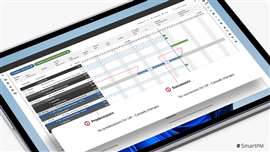How to save money and get ahead with ‘smart’ project management
16 April 2024
According to Deloitte’s 2024 engineering and construction industry outlook, nominal construction spending remained stable in the latter part of 2023. However, the study also emphasised that, while this might seem ideal, there is more to the story.
 Programs for schedule analysis can provide valuable insights into project performance.
Programs for schedule analysis can provide valuable insights into project performance.
“Much of the top line growth is likely being driven by price inflation versus volume,” said the report. “In addition to grappling with ongoing inflation, the industry is facing volatility in material prices and increasing labour costs.
“Another significant challenge is the ongoing shortage of skilled labour, which continues to impact the sector. Moreover, high interest rates and tighter lending standards are also impacting construction activity.”
Higher interest rates are leading to reduced spending in the construction sector, creating a less lucrative industry; when spending flatlines, the industry becomes more competitive.
Amid increasing competition, contractors and owners would be smart to differentiate their company from others to stay ahead.
The economic climate in the construction arena influences financial strategy. During periods of higher spending, owners are more inclined to issue change orders, anticipating that they can recoup lost profits in subsequent builds. Conversely, in times of low spending, when money becomes more expensive, owners scrutinise every dollar, fighting to secure their margins.
This varying dynamic underscores a crucial point: delays are constant in construction, irrespective of the economy’s health. The question then becomes, why do these delays persist despite varying economic conditions?
Creating proactive solutions for construction problems
As we remain worried about the impact of last year’s lead times, price volatility, inflation, labor shortages, and whatever else might impact our builds, I’d like to propose a paradigm shift towards a more proactive, integrated approach.
This is where embedding project controls into the fabric of your organisation comes into play.
With the ample capabilities of emerging construction technology, our hope is that the industry begins to work smarter, not harder, this year with something you already have in abundance: data.
As we embrace this proactive, data-driven approach, it’s essential to clarify the roles and distinctions within the project management framework. A key aspect of this is understanding the relationship and differences between project management and project controls.
These two critical components, when combined, can successfully influence the outcome of your projects.
‘Project Management’ vs ‘Project Controls’
According to the Project Control Academy, there are three main differentiators between project management and project controls.
‘Project Controls’ is a subset of ‘Project Management’ and focuses on managing the project’s cost and schedule.
Project managers direct the work of the project team. Project controllers advise the project manager and teams of potential cost and schedule risks and recovery plans.
Project controllers generate cost and schedule information, while project managers consume the information to make decisions for the project.
In essence, project controls alert stakeholders about the red flags throughout the entire project lifecycle. Project managers can then make informed decisions to control their projects using the data-centric KPIs and reports that project controls provide.
Yet, the industry tends to view ‘project control’ as the responsibility of a person or department. After all, as mentioned above, the responsibility of the project controller is to support the project manager.
While this is historically true, the belief that such responsibility falls on one person/department leaves massive amounts of crucial data unused.
Without effective use and understanding of project data across the board, project managers are navigating aimlessly.
Refining the definition of ‘Project Controls’
Construction’s prevalent issues, without question, are overruns and delays.
There is more than ample proof to back up this statement, and here are two very simple statistics that illustrate that reality:
- Budget overruns: According to a report by accounting firm KPMG, just 31% of all projects fell within 10% of the budget in the last three years (2021-2023).
- Project delays: In 2022 alone, 91% of construction managers surveyed indicated that they were involved in projects that experienced delays.
While there are multiple causes for both issues, most of these problems stem from a fundamental misunderstanding of project controls. It’s not a box-checking exercise or a responsibility to be shouldered by a contractor alone. Nor should it be confined to the realms of a scheduler or project manager. It is a collaborative effort, essential at every level of an organisation.
Project controls are not just a subset of project management; they are its backbone, focusing on meticulous monitoring and analysis. Project managers steer the ship, dealing with client interactions, quality, scope, and approvals. On the other hand, project controllers focus on making data digestible so that project managers can make better decisions.
Even having a project manager in itself can be seen as a kind of project control, along with scheduling software. But each of these resources represents just one step. The only way to have a systematic standard of project controls is by integrating all these systems with technology and using the data to influence outcomes.
Putting the ‘smart’ in ‘smart project management’
Specialised software programs play a crucial role in the construction industry, particularly in creating and maintaining strict project controls.
These software solutions enable project managers to monitor and manage every aspect of construction projects with precision, from the initial planning stages to the final delivery.
Many companies use these tools to generate quality schedules, detailed analyses, and insights to help keep a project on time and within budget. But often these programs are underutilised, as they are capable of so much more, including cost and resource allocation, managing performance, and risk assessment.
Those that feature multitude of integrations offer thorough and accurate data analysis, enabling conversations rooted in truth and informed decision-making.
ABOUT THE AUTHOR

Michael A. Pink is CEO of SmartPM Technologies, a leading construction data analysis tool designed to enhance schedule quality, assess risk, review performance, and control project outcomes.
STAY CONNECTED



Receive the information you need when you need it through our world-leading magazines, newsletters and daily briefings.
CONNECT WITH THE TEAM







